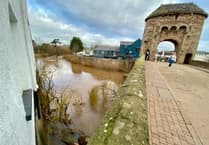THERE are fresh doubts about whether a crumbling Jacobean mansion can be saved after the Welsh Government overturned planning permission to develop it as 54 apartments.
The long-running saga of the fight to save Troy House near Monmouth – described as a ‘jewel in the crown’ of the Wye Valley – has been ongoing for more than a decade.
Fearing that the Grade II-listed 125-room building could be lost, Monmouthshire County Council planners finally gave outline approval in February 2018 for Chepstow businessman Peter Carroll to turn the 1680s mansion into 23 flats, with a further 31 flats built alongside.
But the Welsh Government called the plan in, and after an inspector’s report recommended refusal, Housing Minister Julie James has now overuled the council.
It is the second time in 18 months that the Welsh Government has intervened and overturned a major development in Monmouth, following its decision to stop the building of a spa hotel on a derelict Hadnock Road factory site, also on the grounds of flood risk.
Built by the Duke of Beaufort’s family on the site of a previous building reputedly visited by King Henry VII in the early 1500s, the current Troy House has been deteriorating since the 1990s when it ceased being used as a special school, having previously been a convent.
It has three decorative plaster ceilings which are in various states of decay and need prompt attention, and the building of two new residential wings was meant to help finance the building’s restoration.
But despite accepting that the architectural and historical importance of Troy House justified an “overriding need to save the building”, planning inspector Kay Sheffield recommended refusal on the grounds of potential flooding and development in the open countryside.
She said the mansion overloooking the River Trothy was ‘highly vulnerable’ to flooding, while the substantial amount of “new build” planned at the Wye Valley AONB site would fly in the face of Welsh planning policy.
“There is no dispute the scheme would respect the character and design of the building and be in scale and sympathy with the surrounding landscape…” she said, “but the proposal is reliant on a significant amount of new build on a site which lies within open countryside, contrary to Welsh Government planning policy.”
She accepted that “Troy House is an important listed building. Due to its composition and extraordinary retention of historic fabric, the house is architecturally important. It is also historically important because of its association with the Beaufort family.”
But the public benefit of securing the future of an historic asset through the development “decisively’ didn’t outweigh the disbenefit of breaching other public policies, she said.
Cadw and Glamorgan Gwent Archaeological Trust (GGAT) also said the proposal would be likely to cause significant harm to the registered historic garden.




Comments
This article has no comments yet. Be the first to leave a comment.